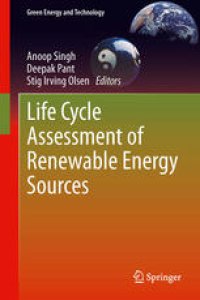
Ebook: Life Cycle Assessment of Renewable Energy Sources
Author: Anoop Singh Stig Irving Olsen Deepak Pant (auth.) Anoop Singh Deepak Pant Stig Irving Olsen (eds.)
- Genre: Technique // Energy
- Tags: Renewable and Green Energy, Renewable and Green Energy, Sustainable Development
- Series: Green Energy and Technology
- Year: 2013
- Publisher: Springer-Verlag London
- Edition: 1
- Language: English
- pdf
Governments are setting challenging targets to increase the production of energy and transport fuel from sustainable sources. The emphasis is increasingly on renewable sources including wind, solar, geothermal, biomass based biofuel, photovoltaics or energy recovery from waste. What are the environmental consequences of adopting these other sources? How do these various sources compare to each other?
Life Cycle Assessment of Renewable Energy Sources tries to answer these questions based on the universally adopted method of Life Cycle Assessment (LCA). This book introduces the concept and importance of LCA in the framework of renewable energy sources and discusses the key issues in conducting their LCA. This is followed by an in-depth discussion of LCA for some of the most common bioenergy sources such as agricultural production systems for biogas and bioethanol, biogas from grass, biodiesel from palm oil, biodiesel from used cooking oil and animal fat, Jatropha biodiesel, lignocellulosic bioethanol, ethanol from cassava and sugarcane molasses, residential photovoltaic systems, wind energy, microalgal biodiesel, biohydrogen and biomethane. Through real examples, the versatility of LCA is well emphasized.
Written by experts all over the globe, the book is a cornucopia of information on LCA of bioenergy systems and provides a platform for stimulation of new ideas and thoughts. The book is targeted at practitioners of LCA and will become a useful tool for researchers working on different aspects of bioenergy.
Governments are setting challenging targets to increase the production of energy and transport fuel from sustainable sources. The emphasis is increasingly on renewable sources including wind, solar, geothermal, biomass based biofuel, photovoltaics or energy recovery from waste. What are the environmental consequences of adopting these other sources? How do these various sources compare to each other?
Life Cycle Assessment of Renewable Energy Sources tries to answer these questions based on the universally adopted method of Life Cycle Assessment (LCA). This book introduces the concept and importance of LCA in the framework of renewable energy sources and discusses the key issues in conducting their LCA. This is followed by an in-depth discussion of LCA for some of the most common bioenergy sources such as agricultural production systems for biogas and bioethanol, biogas from grass, biodiesel from palm oil, biodiesel from used cooking oil and animal fat, Jatropha biodiesel, lignocellulosic bioethanol, ethanol from cassava and sugarcane molasses, residential photovoltaic systems, wind energy, microalgal biodiesel, biohydrogen and biomethane. Through real examples, the versatility of LCA is well emphasized.
Written by experts all over the globe, the book is a cornucopia of information on LCA of bioenergy systems and provides a platform for stimulation of new ideas and thoughts. The book is targeted at practitioners of LCA and will become a useful tool for researchers working on different aspects of bioenergy.
Governments are setting challenging targets to increase the production of energy and transport fuel from sustainable sources. The emphasis is increasingly on renewable sources including wind, solar, geothermal, biomass based biofuel, photovoltaics or energy recovery from waste. What are the environmental consequences of adopting these other sources? How do these various sources compare to each other?
Life Cycle Assessment of Renewable Energy Sources tries to answer these questions based on the universally adopted method of Life Cycle Assessment (LCA). This book introduces the concept and importance of LCA in the framework of renewable energy sources and discusses the key issues in conducting their LCA. This is followed by an in-depth discussion of LCA for some of the most common bioenergy sources such as agricultural production systems for biogas and bioethanol, biogas from grass, biodiesel from palm oil, biodiesel from used cooking oil and animal fat, Jatropha biodiesel, lignocellulosic bioethanol, ethanol from cassava and sugarcane molasses, residential photovoltaic systems, wind energy, microalgal biodiesel, biohydrogen and biomethane. Through real examples, the versatility of LCA is well emphasized.
Written by experts all over the globe, the book is a cornucopia of information on LCA of bioenergy systems and provides a platform for stimulation of new ideas and thoughts. The book is targeted at practitioners of LCA and will become a useful tool for researchers working on different aspects of bioenergy.
Content:
Front Matter....Pages i-xvi
Importance of Life Cycle Assessment of Renewable Energy Sources....Pages 1-11
Key Issues in Conducting Life Cycle Assessment of Bio-Based Renewable Energy Sources....Pages 13-36
The Application of Life Cycle Assessment on Agricultural Production Systems with Reference to Lignocellulosic Biogas and Bioethanol Production as Transport Fuels....Pages 37-78
Life-Cycle Assessment of Biomethane from Lignocellulosic Biomass....Pages 79-94
Life Cycle Assessment of Biodiesel from Palm Oil....Pages 95-129
Environmental Sustainability Assessment of Ethanol from Cassava and Sugarcane Molasses in a Life Cycle Perspective....Pages 131-143
Comparison of Algal Biodiesel Production Pathways Using Life Cycle Assessment Tool....Pages 145-168
Sustainability of (H2 + CH4) by Anaerobic Digestion via EROI Approach and LCA Evaluations....Pages 169-194
Life-Cycle Assessment of Wind Energy....Pages 195-209
Comparing Various Indicators for the LCA of Residential Photovoltaic Systems....Pages 211-239
Hydropower Life-Cycle Inventories: Methodological Considerations and Results Based on a Brazilian Experience....Pages 241-267
A Comparison of Life Cycle Assessment Studies of Different Biofuels....Pages 269-289
Back Matter....Pages 291-293